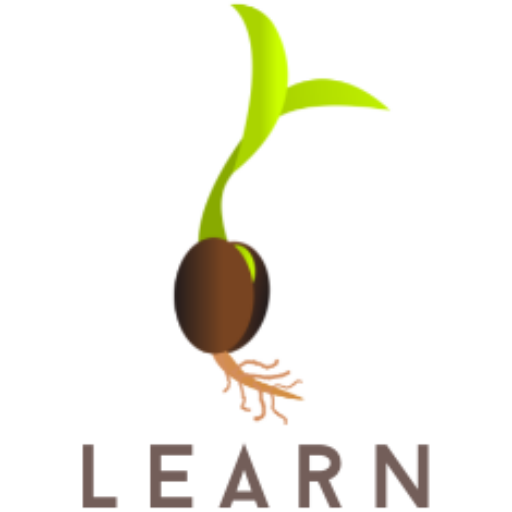Natural Environment
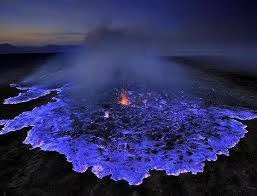
Description: Erta Ale volcano | Credit: Olivier Grunewald
Believe it or not, this is a volcano, but not as we know it or see it more often portrayed. The Erta Ale volcano is a large basaltic shield volcano in the Erta Ale volcanic range (NE Ethiopia), this cerulean eruption that takes place in the Danakil Depression, a low-lying plain in Ethiopia. This volcano is famed for its persistent lava lake which has been active during most of the past decades. The Erta Ale volcano’s lava is the usual orange-red, but the blue comes from flames produced when escaping sulphuric gases burn. (Volcano Discovery 2022, New Scientist, 2014, Erta Ale video)
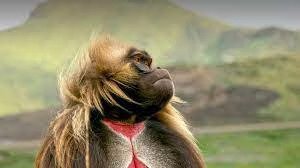
Description: Gelada Baboon | Crédit: San Diego Zoo
The gelada (Theropithecus gelada, Amharic: ጭላዳ, romanized: č̣əlada), sometimes called the bleeding-heart monkey or the gelada baboon, is a species of Old World monkey found only in the Ethiopian Highlands. It is the only living member of the genus Theropithecus, a name derived from the Greek root words for “beast-ape”.
The gelada has a complex multilevel social structure, and they present a diverse repertoire of vocalizations thought to be near in complexity to that of humans. The population of geladas is thought to have dropped from 440,000 in the 1970s to 200,000 in 2008. (Wikipedia)
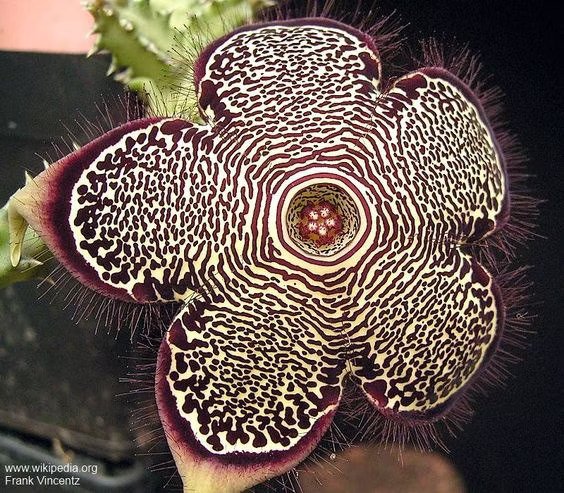
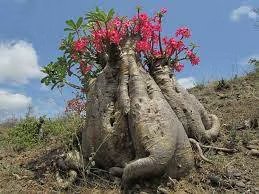
Description Edithcolea (on the top) and Desert Rose (on the bottom) | Credit: Frank Vincentz
Ethiopia is one of the eight fundamental and independent centres of origin (or center of diversity), meaning that Ethiopia is a geographical area where a group of organisms, either domesticated or wild, have first developed its distinctive properties.(Wikipedia)
However, deforestation is a major concern for Ethiopia as studies suggest loss of forest contributes to soil erosion, loss of nutrients in the soil, loss of animal habitats, and reduction in biodiversity. At the beginning of the 20th century, around 420,000 km2 (or 35%) of Ethiopia’s land was covered by trees, but recent research indicates that forest cover is now approximately 11.9% of the area. (Wikipedia)
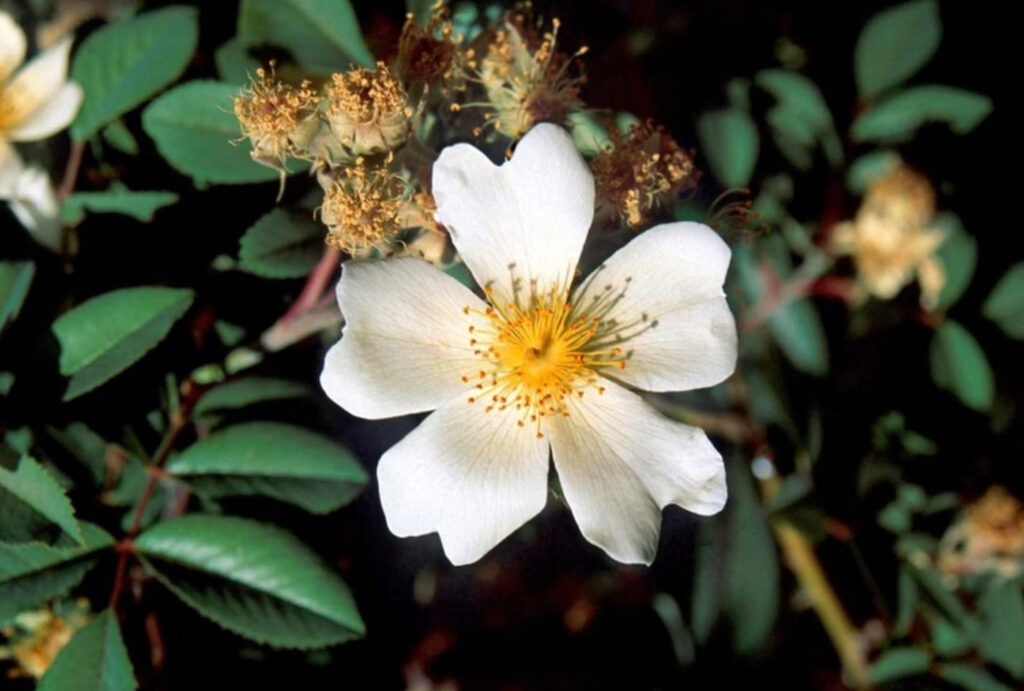
Description: Rosa abyssinica | Credit: West Africa Plants
Rosa abyssinica is the only rose native to Africa, and it is a prickly evergreen shrub, creeping or often climbing, capable of forming a small tree up to 23 feet (7 meters) tall, and it is common in the Ethiopian highlands.
The fruit (hips) of Rosa abyssinica is eaten, mostly by children, and is believed to alleviate fatigue or tension. Birds eat the fruit as do baboons (baboons also consume the flowers). (Wikipedia)
Anthropological History
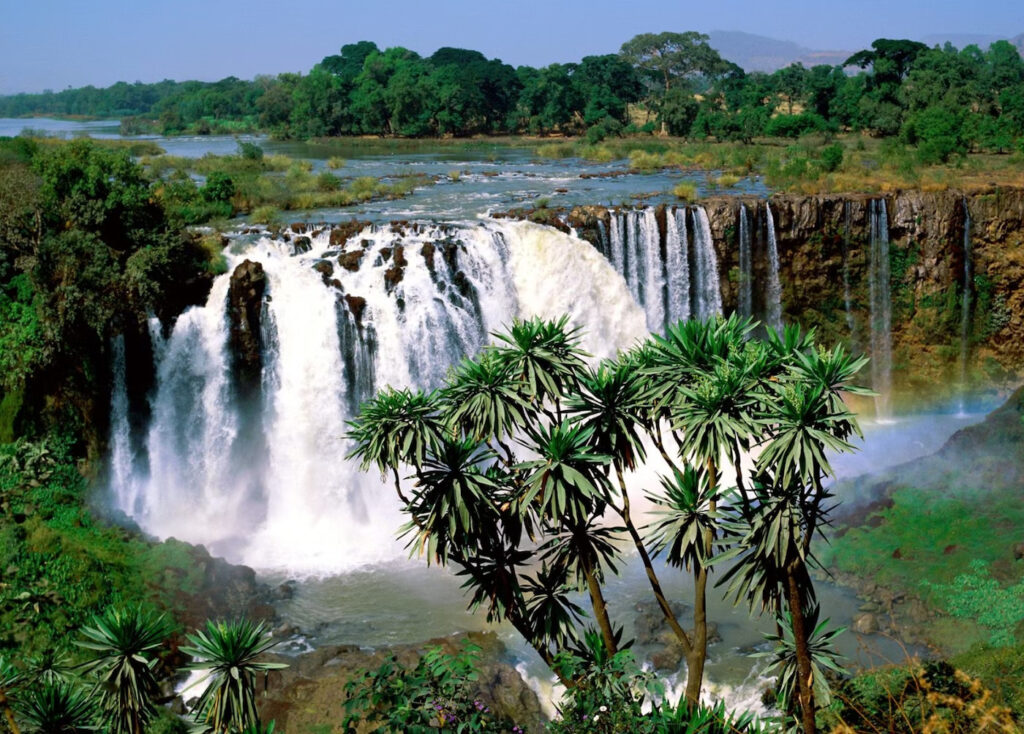
Description: Blue Nile falls (Tis Abay), Ethiopia | Credit: Thousand Wonders
Ethiopia, also known as, Ītyop’iya, Federal Democratic Republic of Ethiopia, YeEtiyopʾiya, YeEtyopʾiy, and formerly known as Abyssinia, is one of the world’s oldest countries.
Dating to around 400 BCE, the region is mentioned in the King James Version of the Bible as the Kingdom of Axum. Along with Rome, Persia, and China, Axum was considered one of the four great powers of the era. Throughout the millennia of its history, the willingness of the country’s people – from farmers to kings – to come together as one, coupled with its geographic isolation and economic prosperity, helped Ethiopia score decisive victories against a series of global colonialist forces. (ThoughtCo)
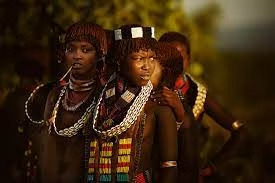
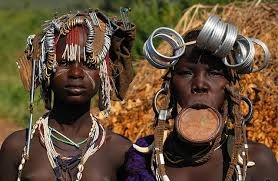
Description: Hamer women (on the left) and Mursi women (on the right) | Credit: Lifepersona.com
Ethiopia’s population is highly diverse, containing over 87 different ethnic groups, between them four of these groups represent almost three-quarters of the population, them being Oromo (34, 42% of the population), Amhara (26,97% of the population), Somali (6,22% of the population), and Tigrie or Tigray (6,09% of the population). (National Consensus 2007)
The diversity of the country’s inhabitants means that many languages are spoken. There are almost 90 languages in use throughout Ethiopia, most of which belong to the Afroasiatic family of languages (Semitic, Cushitic, Omotic) or Nilo-Saharan family (Nilotic).
The Ethiopian constitution states that all languages in Ethiopia are recognised by the state. However, Amharic and Afan Oromo are the languages most often used by the federal government, as they are the most common. Amharic is the official language of Ethiopia and the primary language of the federal government of Ethiopia. (Ethiowebs)
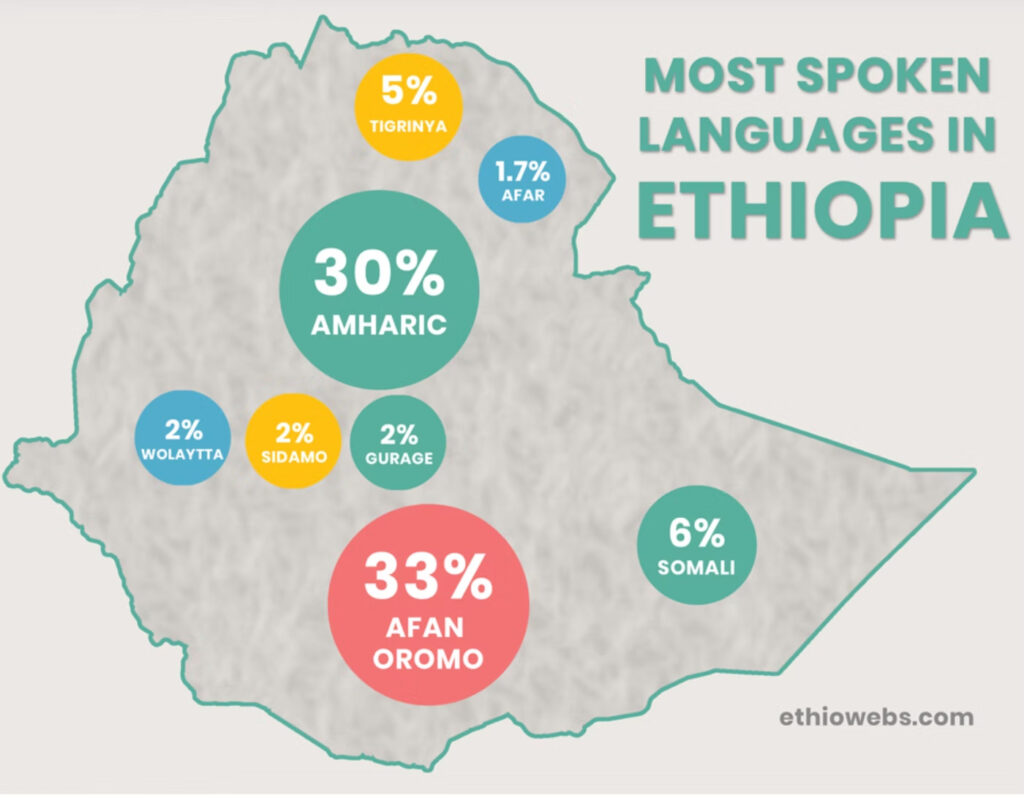
Credit: ethiowebs.com
Society & Culture
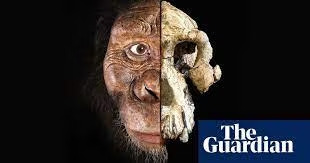
Credit: The Guardian
Ethiopia actually has several other nicknames, having its main slogan as “Land of Origins.” Around 47 years ago, 1974, in Hadar, Ethiopia, a team of paleoanthropologists found one of the oldest ancestral fossils known to mankind; Lucy. Lucy was 3.2 million years old. During her discovery, paleoanthropologists were listening to a famous Beatles song entitled “Lucy in the Sky with Diamonds”, which later inspired her name. (Andariya 2021)

Description: jebena buna or traditional coffee drinking ritual | Credit: Emily McIntyre
Coffee Arabica, first discovered in the ‘Kaffa’ region (from which the name coffee is derived) in south western Ethiopia, grows wild in many regions of the country and has been used by Ethiopians for many years as a food, a beverage and a medicine. It now accounts for 65% of all export earnings. (Embassy of Ethiopia)
The most popular legend of coffee in Ethiopia usually goes something like this: Kaldi, an Abyssinian goat herder from Kaffa, was herding his goats through a highland, he noticed that they were behaving very strangely that day, and had begun to jump around in an excited manner, bleating loudly and practically dancing on their hind legs. He found that the source of the excitement was a small shrub (or, in some legends, a small cluster of shrubs) with bright red berries. Curiosity took hold and he tried the berries for himself. (The Spruce Eats)
The jebena buna or traditional coffee drinking ritual is not for anyone in a rush. It can take about an hour because the coffee undergoes certain processes that form part of the communal bonding time. The traditional coffee-making ceremony or buna is a community-oriented ritual. It is performed by women usually clothed in traditional garb who first wash the coffee beans before roasting them over hot coals until they are burnt and black. (Ama Nunoo, on Face 2 Face Africa)
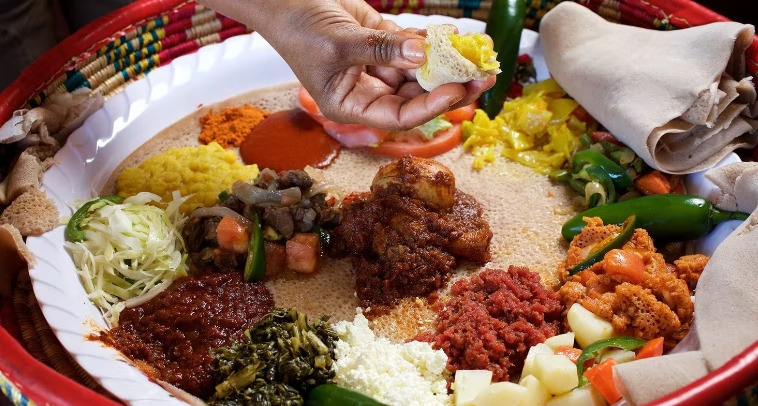
Description: Injera bread being served with many delicacies on top of it | Credit: Wisconsin University
Injera (Amharic: እንጀራ, romanized: ənǧära, [ɨndʒəra]; Oromo: Biddeena; Tigrinya: ጣይታ, romanized: ṭayta) is a sour fermented pancake-like flatbread with a slightly spongy texture, traditionally made of teff flour. In Ethiopia, Eritrea, and some parts of Sudan, injera is the staple. Injera is central to the dining process, like bread or rice elsewhere.
Traditionally, injera is made with just two ingredients – teff flour and water. Teff flour is ground from the grains of Eragrostis tef, also known as teff, an ancient cereal crop from the Ethiopian Highlands.Teff production is limited to certain middle elevations with adequate rainfall, and, as it is a low-yield crop, it is relatively expensive for the average farming household. As many farmers in the Ethiopian highlands grow their own subsistence grains, wheat, barley, corn, or rice flour are sometimes used to replace some or all of the teff content. Teff is, however, the preferred grain for making injera, primarily because of its sensory attributes (color, smell, taste). Teff flour is gluten-free grain. (Wikipedia, Eater, The Daily Meal)
Ethiopia is a musically traditional country. Popular music is played, recorded and listened to, but most musicians also sing traditional songs, and most audiences choose to listen to both popular and traditional styles. Ethiopian music is a term that can mean any music of Ethiopian origin, however, often it is applied to a genre, a distinct modal system that is pentatonic, with characteristically long intervals between some notes.
The music of the Ethiopian Highlands uses a fundamental modal system called qenet, of which there are four main modes: tezeta, bati, ambassel, and anchihoy. Three additional modes are variations on the above: tezeta minor, bati major, and bati minor. Some songs take the name of their qenet, such as tizita, a song of reminiscence. When played on traditional instruments, these modes are generally not tempered (that is, the pitches may deviate slightly from the Western-tempered tuning system), but when played on Western instruments such as pianos and guitars, they are played using the Western-tempered tuning system. (Wikipedia)
Current Socioeconomic Crisis
Across the globe, global commercial demand for arable land is on the rise. One of the most profitable new agricultural hotspots is Ethiopia.
Farmland – the new green gold. In the hopes of huge export revenues, the Ethiopian government is leasing millions of hectares of land to foreign investors. But there’s a dark side to this dream of prosperity.
The results are massive forced evictions, the destruction of smallholdings, state repression, and a vicious spiral of violence in light of environmental devastation. Global institutions like the EU, World Bank and DFID are contributing to this disaster with billions of dollars in development money every year. (DW Documentary)
How do you go from winning a Nobel Peace Prize to being accused of horrific war crimes in just two years? That’s the situation facing Ethiopian Prime Minister, Abiy Ahmed. For months, Ethiopia has been in the middle of a violent civil war with the Tigrayan people; an ethnic group that lives in the country’s north. As many as 50,000 people are said to have died, which, if true, is more than any conflict anywhere in the world in 2021.
Tigrariayan region is a land where it is possible to cultivate, but many farmers have been threatened by the military and government on their own land if they try to grow food, but the government denies it. Starvation has been used as a weapon of war, a weapon of elimination. This is a 100% man-made famine, journalists reported. (Ethiopia Insight, 2022, Behind the News)
In Ethiopia, a civil war has left tens of thousands dead and millions displaced, as government troops and the Tigrayan People’s Liberation Front battle over territory. An investigation by the United Nations found all sides in the conflict had committed violations – including using rape as a weapon of war.
Noel Iglessias and Negede Gezahegn, founders of DANA Social Group, and LGBTI rights organization in Ethiopia, discuss their journey of seeking asylum in Austria after their activism left their lives at risk in Ethiopia in a conversation with Klaus Mueller. The conversation took place during the fifth session of the Salzburg Global LGBT Forum on ‘Home: Safety, Wellness, and Belonging’ in May 2017. (Salzburg Global Seminar)
Ethiopia is one of the 54 countries in Africa where being queer is illegal and punishable by 15 years to life in prison. There are no discrimination protection laws in place and no institution recognizes same-sex union. The LGBTQ community on Ethiopia is always constantly battling with high level of discrimination and abuses. (Judy Bokao)
